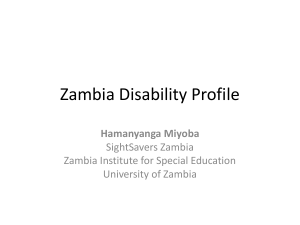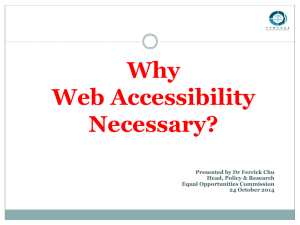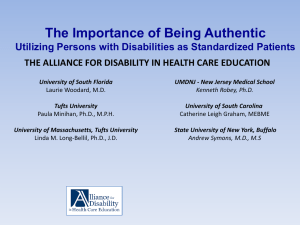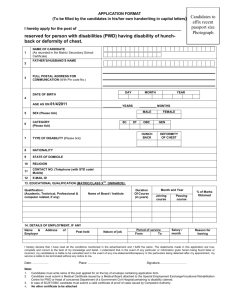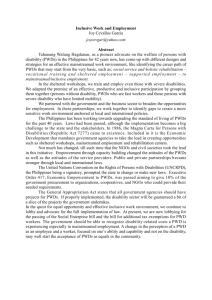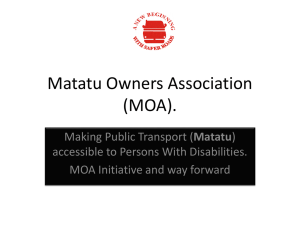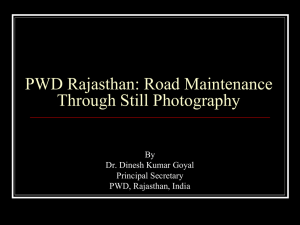Consultation In-Person Feedback Collection Location: Abbotsford
advertisement
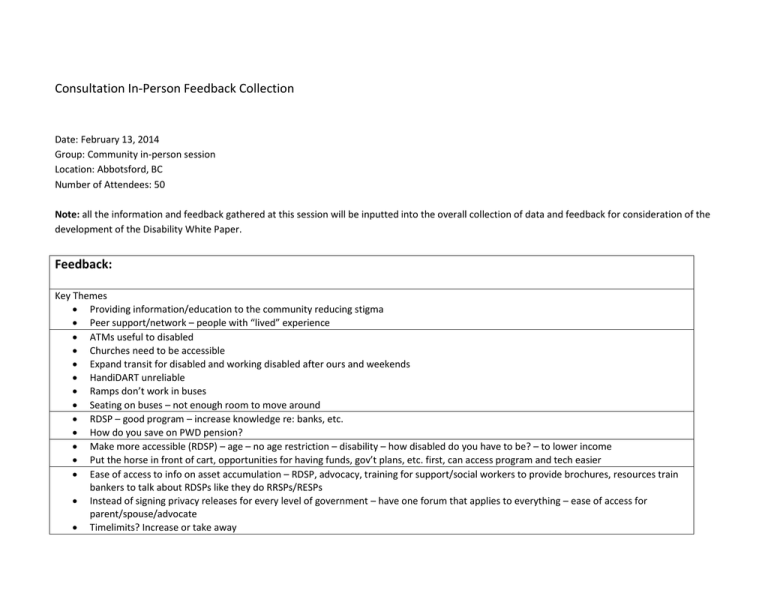
Consultation In-Person Feedback Collection Date: February 13, 2014 Group: Community in-person session Location: Abbotsford, BC Number of Attendees: 50 Note: all the information and feedback gathered at this session will be inputted into the overall collection of data and feedback for consideration of the development of the Disability White Paper. Feedback: Key Themes Providing information/education to the community reducing stigma Peer support/network – people with “lived” experience ATMs useful to disabled Churches need to be accessible Expand transit for disabled and working disabled after ours and weekends HandiDART unreliable Ramps don’t work in buses Seating on buses – not enough room to move around RDSP – good program – increase knowledge re: banks, etc. How do you save on PWD pension? Make more accessible (RDSP) – age – no age restriction – disability – how disabled do you have to be? – to lower income Put the horse in front of cart, opportunities for having funds, gov’t plans, etc. first, can access program and tech easier Ease of access to info on asset accumulation – RDSP, advocacy, training for support/social workers to provide brochures, resources train bankers to talk about RDSPs like they do RRSPs/RESPs Instead of signing privacy releases for every level of government – have one forum that applies to everything – ease of access for parent/spouse/advocate Timelimits? Increase or take away Feedback: RDSP/dos not work for everyone – age restriction Not many PWD can save $ on limited income Need more education/information for PWD clients who receives inheritances – PWD clients may not know where/how to get info More $, rates increase to allow for savings Advertise, make people aware Accountants don’t know much about it Banks need to be aware and provide service Advise feds to expand awareness Increase PWD benefits by ie $25/month and automatically contribute to RDSP rather than taking their money Widen eligibility and age you can contribute to 55? Accessibility in the public – coffee shops, public places, biomedical labs – doctor offices – lack of space (wheelchair) – more user friendly access w/building codes Better structures – sidewalks, ramps (live where they want to live) Public transit training - cross training Costly for transit for PWD that cannot take public transit – difficult wait times Increase housing subsidy, increase IA rates Safety, respect and dignity important Housing causes mental health issues for clients with IDD Transportation lacking, ie. HandiDART Wheelchair access lacking/not maintained by landlords Not enough options Have ownership very difficult for PWDs Something like an RDSP for housing Making a home accessible for PWD sons/daughters – government needs to provide a housing allowance to help with accessibility for a growing child Find a corporate sponsor ie. London Drugs to support our PWD community ie. cell phones, laptops, iPads Scattered site housing Increase in rent amount by Social Development Transit needs investment – bathroom facilities Industrial areas need transit for people to go to work Explanation /training how to use Greater accessibility – greater distance – specialist, support to attend appts. Feedback: 211 – publicize – expand service One stop portal online for requesting – multi service centre – public transit, assisted living Building tax credit/tax breaks for builders/building accessible environments, ramps (churches) Families providing services to these client are not skills supportive enough for high needs clients Integration clients are not being consulted when group homes disbanded - no continuity for clients Transportation (absolutely!) – remote town – ability to access – relooking at HandiDART – volunteer groups of drivers (like operation red nose) PWDs hired that can drive, employed as drivers for PWD More access to funding for housing and equipment Follow Vancouver’s lead in setting standards for making homes built for all ie. counters and light switch Companies that are certified to handle modifications Make city bylaws make sense ie. more parking for scooters rather than vehicles Low income housing into areas that are safer, secure and have access to neighbourhood shopping, etc. More access to funds for down payments for own housing Pay attention to other countries how they make things more accessible Better sidewalk access in neighbourhoods and city centre More inclusive housing – low income housing that still accessible both financially and physically Adaptive independent living in the community vs. facility More creative funding/support for families – mentors, workers, support persons, monitoring network Affordability to stay in their home and adapt it to their needs (new injury or inherited disability) Location, quality of BC Housing Disbursement of the type of building such as an apartment building that would have to have minimum percentage for adaptive/accessible living Rental subsidy for disability Speed bumps too high Example “hockey arena” was built without considerate of PWD (steep stairs) PWD/homelessness/more safe affordable housing – rates not adequate for housing More standards of quality for affordable housing – landlord charging high rates with poor living conditions – more monitoring for quality housing Supportive house, teaching semi-independent housing – more places like “First Ave” run by communities – more people on site to support/each independent living More opportunity for indep. Living for PWD that are more independent Socialization/support – teaching people to make meals, take care of own living spaces Feedback: Reducing rental rates/standardize for PWD – SIL – allowing funding has reduced – should not be temporary People are limited to where to live due to costs – not easily accessible/transit – safe areas Universal design and expanded accessibility standards More accessible, safer low income housing for all types of families – single, single parent, 2 parent w/children, couples, (not a ‘project’) Work w/ developers (must have handicapped incorporated) On BC Benefits dietary supplement, $40 does not cut it when you have gluten problems – should be same rate as supplement for water vitamins (sic) Accessible (wheelchair) venues (especially government venues) Enforcing the building code – not happening Aging in place design DVDs – need captioning standard of using captioning Broaden standardization for visual devise, hearing touch pads BC Benefit – married, cut at $200, and incentive $100 one does not benefit Buildings/housing to be built to accessible codes – visitable – increase $ hospital release (until home is accessible) Standardize sidewalks to accommodate – beepers, curb cuts, pork chops, hydro poles, curved sidewalks, wide enough – 2 chairs side by side, pavement, potholes, etc. HandiDART for all hours More accessible taxies Bus stop – ramp on bus can’t go flat Elevators at SkyTrain stations Affordable, accessible housing Wider variety of options housing ie. 2nd any suite eligibility (sic) Cost of living – IA as to what community costs are for housing Disconnection b/t employers and clients Rec Centre – struggle to access – lack of support by City – may reduce barriers – sense of connection – accessibility – structural Educate the community – engage the community, employers – make part of training – promote Expand the ‘outings’ do not designate specific locations Awareness – assumptions that PWD cannot understand, make decisions Lack of funding to engage clients in social setting educational settings Life skills workshops Language for disability, emphasize physical disability and not intellectual disability Labelling disability Feedback: Passions of individuals are not emphasized Language in disability No cookie cutter approach to individual, it does not fit everybody Barriers to employment Educate employers Provide multimedia interface to showcase a person’s abilities Provide volunteer opportunities Circle of support – wrap around care for people to assist with getting thru system Take funds from various ministries to assist to cut funds Closer partnerships with Social Development Circle of support and accountability NOLA program (M2/W2 Association ) No one leaves alone Ministries working together for seamless transitions for disabled children aging out and entering adulthood eg. MCFD and CLBC moving into one ministry Consultation – needs to be inclusive – what assists one disability group may hinder another ex. computer forms Include churches in process Use of technology needs to include training to all users (extended family, supports) Tutorial or button that says if you can’t use this click here for alternate process ‘access transit’ Trailblazers Canada in comparison to other countries Not successfully accessing and developing systems Need to be more people centered Alberta shows strength in their area Even different communities in BC vary – need to be more consistent Streamline resources to make more accessible and mainstream ie. like 211 make info line Make first contact more info available Practical services covered under MSP/government funding Access to technology – help with expression EATI – what will replace it? Carry forward after school Funding, assessments, devices should follow person rather/or both with program One place where access to tech/resources easier for families/persons Feedback: Funding for one-on-one support Better division of funding for needs- based (disability) rather than categorization Person-centred planning/care Assessments to help to create Targeted funding Training day support works to provide job coaching – using existing resources more efficiently Customized employment specialist Whether you have a disability everyone has potential – we all need opportunities – people need to feel wanted and needed, bring people closer More professionals in the community to attend local support groups – going to PWD as they might not be able to come out to the community due to lack of access – be more aware of/more awareness of PWD – a lived experience come and speak with people in the community/at MSDSI – more awareness to treat PWD clients better Not everyone can afford line lines (sic) more free benefits for PWD – more accessible information as not everyone has computers, landline, TVs. Buddy systems – assist PWD with going out not be alone/shut in – friendship/peer support/mentoring – volunteer drivers PWD may not have skills/education to find resources – funding cut for assisted programs – speakers had gone out to talk to MSDSI, police, e. response workers to give education about PWD Less paperwork Not used right language – same language PWD – app. way too long Plain language on paperwork, communication – clear instructions Selection info – criteria Rejected because not worded “correctly” – not good Ex. Dir didn’t say was related to the condition so denied (family needs to have the info of what’s needed) Assumptions – assume form is right form Greater family centred – ind. w/disability in a family unit IDP – early intervention 0-3 yrs) (infant develop) – really works good “in the beginning” once out of that program it breaks down 3 – 5 ok, not as good School system – breaks down Family centred approach for SDSI – (0 to end years) Eliminate the transition between child and family services (from child to adult) Family – shouldn’t be approached from a SW child protection point of view – disrespectful to the family Takes village to raise a child Feedback: 19 year old – disability fair (info hasn’t been circulated well) Information getting to “right” people – 1 fixed point to getting information (all info related to disability) Could be a website or catalogue – info for any PWD issues Awareness of PWDs in the workplace Models of success are shored w/appropriate people Equal opportunities for all More gov’t funding for rehab for special disability groups – ie. people who are blind – funding by charity – CNIB Hard to get PWD – red tape when IA goes to other who are able PWD very stressful for those who obviously are disabled Fair application system Recognize illness/disability Recognize own abilities, encourage others Bartering system The person must take responsibility and attitude can alleviate barriers Support that there is a job for everyone Costly, not readily available – software Lack of awareness for support workers where technology awareness can assist them in supporting their clients Use technology to highlight ability, skills enhance enjoyment of life Accessibility to technology should be readily available/or provided to everyone Corporate partnership with corporations ie. Apples for iPads, laptops, etc. Provide recreational facilities/support to increase self esteem Government media blitz to hire PWDs Involve 3rd party multimedia to enhance people’s skills, both academic and work Provide medical equipment and supports Items to make life more accessible – glasses every year if has an eye condition – access to braces if necessary – easier access to (sic) – some have lack of confidence, unable to follow thru on own One on one help (coach) to assist those with low self-esteem etc. and to disability challenge (sic) Assist with budget Supports for self-employed who become a disabled Education re: resources People need people Continue EATI Feedback: Training – disability awareness training like SuperHost/Serve It Right for businesses/retail/etc. Contractors to government services – also human resources Car adaptations – funding? HandiDART is too restrictive for more dumping/rural areas/time issues Cuts to funding is really impacting adults for personal support – respite – not equitable or coordinated Access to technology is expensive and limited Cost of equipment Social development – disability assistance – MSP – provide for hard of hearing not visual Supports – more involved in employment (carers) When budget gets cut, people w/different abilities let go, not supported in staying employed Earn more while on disability Run more programs for adaptive equipment Equalize people that have different abilities ie. people w/autism qualify more than people with vision impairment Definition of disabilities needs to be broadened to encompass all people Training for equipment and technology provided Cost of prosthesis etc. after health care and extended health runs out Transportation limitations – barriers to employment, accessing resources centres, etc. Cutbacks to taxi-saver hurts this initiative WorkBC needs to follow-up with PWD clients that want to work Better transition supports in place between post-secondary - high school and work Better case management between teenage to adulthood – financial, emotional, social, medical MCFD support system to help with transition at 19 – for better flow through One stop shop for finding resources, employment, funding, mental health, etc., devices, aids for adults BC Works with more follow through and funding A number like 811 for PWDs for info Handrails in hallways, houses – direct lines, face to face contact Supportive housing/workers to check in on PWD – clients need to feel comfortable to reach out Elevated toilets (hotels, public restaurant, etc.) – standardize In office, sit down and talk about issues (financial, etc.) early diagnosis – club houses (standardized) – staff would go out get entry level jobs – break down jobs and staff trains PWD for the employer – once PWD completed job, employer gives a reference for the resume – companies to have a % to hire PWD – handle chore in the shower for safety (sic) Physical devices, therapeutic, dogs, equipment, etc. Some diagnosis get approved quicker than others (and we don’t know why the difference) Feedback: Approval for devices taking really long (up to 2 months) Fast track – equipment for those who have employment With a tax credit for disability equipment Some at home program supplies are not financially paid for – need to cover all necessary supplies eg. diabetic strips/syringes Increase of independent of gov’t advocates If can’t afford supplies ie. diabetic strips – are at health risk Ie. supplies that fall outside of payment structure ex. sterile wipes for hard of hearing Inequity of funding (supports available) eg. autism vs. Down Syndrome (children) (needs to be equal regardless of diagnosis – needs based how function) (sic) Hearing loss – cost of hearing aids are extremely expensive – seniors are on a low income and pay no income tax Be included based rather than excluded from society Funding needs to be based on individual need rather than “labels” or IQ based Gov’t be on board with ‘state of art’ therapies – be up to date on what’s available in all areas and communities Adult home support needs to be totally revamped and “individual friendly” Family centred approach for personal supports Not enough counselling for PWD Bring back EATI with a wider eligibility criteria, ie. community/leisure accessible to all ie. lifts/tables/changeroom for ppl who cannot stand Provide successful people with disabilities to show success to others/encourage Increase accessibility to hotels, etc. – knowledge of what criteria is in communities Accessibility experts or more aware in building codes Inter comm. connection w/all programs – mentoring/socialization /networking Agreement w/community laces to use spaces for meetings/socialization when spaces aren’t being used instead of the same designated places (at same program places) Education for family member to help with indiv. Support/involvement More support for families for clients prior to adulthood as well as after – isolation/barriers/social activities Needs to be a com. effort at an earlier age Schools – PWD – inclusion – Wolf Pack – Choir – School Dances – extracurricular activities Create a Facebook page Open communication, dialogue onoing Organizations networking together ie. Fraser Health, Bands on Rescue, government, CLBC, etc. ‘Special Olympics’ is a good organization and other organizations can model after it to increase social networks for PWDs Feedback: Family network Circle of support – present in a person’s life Faith community Harning Place – owners rent bsmt suite to PWD Volunteering Continue/increase funding for community day programs, community inclusion/outreach Cost/transportation are barriers Encourage/support ‘meet and greet’ social programs Regular community resource meeting to exchange info/services/gaps Community network initiative – bring in funding/education/resources Friendship circles – planning session every six months to assist PWD in expanding support/move forward – building on paid support (family/friends/neighbours) If I am a person with a disability and feel I have been treated unfairly - who is it safe to complain to? Transportation Have separate networks w/PWD join forces, rely on each other’s strengths Online, create forums that are safe secure, moderators w/background checks Education in community for awareness ie. child’s behaviour may differ, be understanding Advocacy – ‘why’ this is something we need to kick at Using advertising/campaign to show different abilities and integration and acceptance Latter Day Saints commercials – showing how a child w/autism might have a tantrum and parent helping to resolve Spread community inclusion to ethnic/cultural groups Rec. programs made for inclusivity with special supports Club teams having mentorship (buddy programs) to include PWDs School – mandate to include differences such as ethnicity, disability, etc. and learn ‘inclusiveness’ Social setting, atmosphere to include persons with and w/o disabilities to encourage inclusion Social outlets for PWDs Teaching education about disability and ability at a ‘young’ age – so there is less ignorance and change how society views disability TV shows showing more PWDs to tech people not to be ashamed to have a disability/barrier Self-esteem workshops More funding for counselling Focus on ability and awareness Employment peer support (people with lived experience) – helping socializing with PWD – support from someone who has lived the Feedback: experience One stop health centre ‘like in Chilliwack’ – medical, health, mental health, etc. Communities need to be more supportive with PWD – have more advocates to educate communities to be more supportive Subsidize costs for socializing – community centres Have/hire people to take PWD /groups on outing (camping, day trips) Value family and their input Individual input Welcome families Accessible services for First Nations on reserve 211 – now was redbook (sic) Websites – www.selfadvocatenet.com Navigate through services tough Education – lack of grants for an education trade – can’t necessarily get a job once you have the training so to take out a loan and then pay it back with no guarantee of work is ridiculous Accessible transportation Open doors ie. Work BC to ppl to meet and interact Community club Should have access to community centres/all schools, etc. to use for mtgs/groups, etc. We all pay school taxes so they should be open to public Combine community and resources ie. WorkBC in local library “jumpstart” program for ppl who want to take a course, learn guitar, etc. “meetup” website Can’t define to ppl what their community should or shouldn’t be Transitioning programs like KPU – access program Start training in the high school, include basic raining like FoodSafe, Serving It Right, etc. for PWDs Employer – participation, incentives for ‘career’ based companies to hire PWDs Flexibility, accommodation , inclusivity, training – 1 HR person w/training to help support PWD BC Works – expand to job training – jobs to cater to abilities of different levels of disability Work experience programs Mentorship programs between university, work-seasoned persons w/disabilities and high school students Paid work for PWD Employment standards clarification re: hours worked with exemption ex. one person works 5 hrs - $275.00 a week – some people – 2 hrs to get much less $ - Feedback: How do we attract employment for PWD? Demonstrate visually (success stories) on PWD that have been a good fit eg. apprenticeship programs (slippery slope – so be really cautious) Be available for PWDs with timely support to provide a proper work environment w/the disabled Gov’t and union understanding awareness of disability (acceptance/belief/value/honour that the person has a right in a meaningful way – fully contributing) All community members demonstrating respectful attitude, interactions, language used, regarding disabled individuals Fear of retribution families don’t ask for more Community awareness – expand emp. Opportunities Educate – abilities vs. disabilities More finances Mentorship program/training for PWD More emp. Opp. As a whole – general/PWD Financial incentive to bring more employment in to hire PWD – communication/trust – advocacy Harder for more PD to obtain employment – integrate into the community Employment needs to be longer in duration – long term More mentoring opportunities Move opportunities to showcase PWD abilities Creating opportunities for PWDs to show their abilities transitioning from school to employment Start a dialogue in school about disabilities so people are more inclusive to diverse (sic) isolation More emphasis on ‘capability’ of a person start from school Increase understanding in our community and employers re: disability Increase support workers and social workers In school, more interaction between students Increase education re: disability In remote communities, disability infrastructure is lacking More assistance for those with barriers Client focus groups More one to one Transportation is biggest issue (HandiDART, poor transit service) More opportunities for mainstream training with adaptations (don’t wait until enough PWD to run education) Gap exists between to access (sic) funding/training between high school/higher education/funding (lack of awareness of opportunities) Bring back ‘sheltered workshop’ ie. cooperative social work settings Feedback: Bridging to employment People need to be more sensitive towards disability needs ie. a personal support person viewed like other assistive devices ‘selling’ employers on benefits of people w/different abilities Get the stories out of the success Communities come together ie. Powell River – lower barriers to integration and funding by government Provide employers with awards of recognition for hiring PWD Get information out Approaching corporations for funding of programs (proud sponsors of….) Tax breaks – make more attractive, purposeful, incentive for companies to hire Companies/businesses to employ PWD – incentives to employers Social enterprise/making a product that PWD gets paid for Self-discovery/assistance/support Encourage employment with employers to hire PWD Some PWD lack training/support they need even after they get a job – ongoing support, some people have never had a job Help PWD recognize and help the feel valuable – work with bio-medical people to assist in adaptation PWD working at human resources Cashiers that sit instead of stand Better ergonomics for workplaces MSDSI has improved with work exemptions Employers need to be aware of PWD ie. rise and fall, endurance – education Let people/PWD know the job, joy of work Not enough trades/apprenticeships CEO of CLBC quoted 70% disabilities out of work (2014) Individual choice on what work is a ‘contribution’ for the handicapped/marginalized Employment opportunities need to be meaningful Awareness WorkBC is the only choice variance of expertise needed to PWDs Underfunded for what the WorkBC can provide Ppl better served when there where a variety of suppliers Employment equity act (diverse workforce) in the Province of BC – like feds have Support/act for ppl disabled after hired on the job – incentives for workers Apprenticeship or mentor ships Feedback: Wage subsidy Make employers aware of PWDs’ capabilities Should have advertised to community/employers who should be a part of the White Paper/awareness Solution Wall Posts: Mandated inclusion in schools so it becomes “the norm” Education for employers/community/families/police/health care workers/to break down barriers Widening of the definition of PWDs Planning should be person centered Education community reducing stigma – everyone has knowledge of physical or mental health disability with extended family The special process is unnecessarily complex for people with mental illness or developmental issues Housing needs are not being met – either additional subsidies are increased PWD is required to ensure that people have safe and affordable housing options Access to mentor-support person to assist PWD after they turn 19 – to help them transition into community Housing – accessibility to benefits – encourage peer support Educator in school systems to bring down the stigmas associated with disabilities - a new generation would emerge where the stigma isn’t there $ More funding for various support – recreational ‘buddy’ system – life mentors – job skills searching/training – more transportation options Separate assistance office for PWD status from general “welfare” office If they won’t come to you, go to them – every person is a different situation – satisfaction in life fulfillment in work, leisure and life – break down barriers in participation Find corporate partner(s) to access technology innovations of reduced cost ie. London Drugs providing recycles cell phones/laptops, etc. More $ for those on PWD/families supporting – agencies providing services (so they can have better, well trained workers) Simplify communications with Social Services – the PIN # people need when they call makes access difficult Spend a day in a wheelchair – spend a day blindfolded – different levels of disability – everybody’s situation is different – no two people are the same No on reserve services – need for development of service providers on reserve – education and aware ness – groups of children and adults talk in schools and Chamber of Commerce Increased access to technology Make adaptive equipment readily available Inclusive mentored support – more accessible, affordable housing Database for diagnoses and permanent disability – designation to be shared between gov’t services Create broader opportunities for education and information sharing about the abilities of individuals with disabilities with respect to employment and academic interests Individual funding instead of a funding pool for disabilities in schools More access to programs like EATI or CAYA for problems with speech Better access to open an RDSP – train all loans officers at banks Websites – access to information for PWDs Accessible buildings – wheelchair ramps – automatic doors – working elevators – safe parking spots Mentorship in the community Have respite/supports for families and also provide education tips and strategies for families – this may ensure less burnout and stress Mindfulness (ongoing) to bring in all community Make it easier for self-employed people who become disabled to get assistance Helping families w/extra legal costs of special wills needed for our disabled children Expanding EATI and keeping it Models of success are shared with stakeholders Families want meaningful opportunities for contribution in community The Minister of Transportation should have to use only public transit for one month – transportation barriers affect all six areas Building codes need to be upheld to a higher standard Create a barter system between PWD (I’ll babysit – you fix my car) Highlighting value, contribution of individuals Take a ‘family-centred’ approach to respite Family centred approach in all areas Family centred phil. And approach New developments have at least one accessible suite Awareness of the benefits of hiring PWD Expand HandiDART hours More support for form applications Eliminate the ‘rich’ labels of autism re: funding and value children w/Down Syndrome etc. w/appropriate supports as well First job or new job – apprenticeship program If on IA – shelter amount is based on the community you live in Community needs to demonstrate and celebrate the success stories which hopefully promotes awareness and removes myths associated with disability Supports to complete forms and to refer to supports agencies Support the group home concept for adult living- more continuity than home share model Reinvent the ‘sheltered workshop’ concept…doing meaningful work in a social setting Transportation is a great problem for PWD – people need people Communities that collaborate and share information and resources – the residents are better supported Better define label of PWD – not have it (sic) People need people – need help with technology eg. online job applications ) or to by-pass technology eg. a real person vs. an automated voice or computer System for adult hoes where clients stay and workers change Disability awareness training mandatory for retail/business/etc. similar to Super Host seeing it right Wider variety of options for affordable housing, access We all pay school taxes – they should be open for public use – neighbourhood hub Increase PWD by $25 and put it into RDSP PWD union awareness for employer with disability Community development for inclusion projects Funding across the board for necessary medical device or medical supplies Standardize store/bank touch pads to make accessible – now very difficult Equal funding for all designations not just for diagnosis for autism Future housing developments should include at least 4% of the units accessible Federal transfer payments can use for employment projects and support health Language disabilities ie. immigrants re: work (sic) Consistency of value of child – look PLEASE at funding and supports for children w/Down Syndrome compared to those with the “high functioning autism” – mindbogglingly (sic) inequitable Circle of support Value family around and supporting child not just child ie. see respite example of Cold Water Ranch Lodge Honour our child with disabilities by demonstrating and highlighting their value and seeing their meaningful contributions Look at individual needs – eliminate ‘autism’ funding unit and show some social equity and value – gov’t $ now shows children w/Down Syndrome – lower value and social class – unjust Increasing the capacity for people with ‘lived’ experience/disabilities to provide peer support and education/information to landlords, employers and community Prevent situations like the George Pearson situation w/potential of institutionalizing individuals w/disabilities Cutting Red Tape: “Jordan’s Principle” – on-reserve First Nations people living with disabilities falling through the gaps – CLBC says AANDC responsibility is up to First Nations Health Authority, or Dept. of Indian Affairs – but no specific funding (except PWD disability) for on-reserve special needs community members – break down jurisdictional barriers for the sake of the individual Having to constantly prove income/disability Getting the run around of First Nation people PWD – they keep being passed around and no one wants to take the responsibility that PWD need support and services on reservation, to live more quality lives Access to ongoing assessments as needs/abilities change – not SLP/OTs/PTs being capped – rehab funds Less lead time for okays for AFOs, etc. Current applications (PWD, RDSP) process is too long and complicated – creates stress – becomes a barrier – most cannot complete without assistance which cannot locate Being categorized (mental health vs. acquired brain injury vs. having both) – different funding/access depending on where you are Train day support staff to be job coaches Work with municipalities to build more access housing units that are inclusive Expand, publicize and utilize 211 so PWD can access all resources; 1-800 contact Get rid of POWD applications; social workers at CYSN have a file that can be sent to CLBC Have someone who will help families with paperwork and forms Reduce amount of government forms Stop political pastoring – hold ups, not a business, non-profit, help those in need Cut (out) the PWD application Reduce PWD application – more public awareness around issues facing people – we need to invite PWDs Eliminate transition between kids and adults Equal funding across the board for all those with disabilities Community network meetings not attached to any ministry – agency to plan for community need Eliminate the PWD from child to adult (paperwork) Have one application form for parking passes, park passes, etc. (sic)

